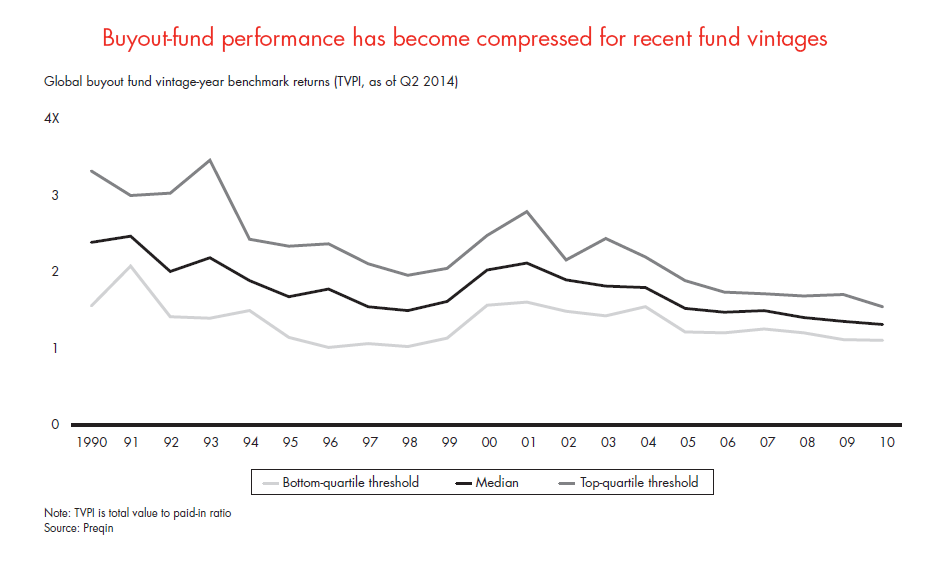Forbes.com
This article originally appeared on Forbes.com.
The notion that past performance is a reliable indicator of future returns has been a proud hallmark of private equity (PE) investing since the industry’s earliest days. For institutional investors, the task of separating the top-performing PE firms from the laggards was a pretty straightforward business. The best guide for institutional investors selecting a new fund to invest behind? Look at how the firm’s previous funds fared.
No longer. As we explain in Bain & Company’s Global Private Equity Report 2015, the conditions that made it possible for top PE fund managers to cruise from success to success have washed away in a flood of money-chasing assets in today’s world of superabundant capital. The democratizing influence of plenty of money in the hands of many has had a leveling effect on PE returns. The combination of high acquisition prices and longer hold periods is eroding returns. Meanwhile, slow but steady economic growth in major developed markets has put a floor beneath the returns of the weaker PE performers.
The cumulative result of these shifts has been to compress industry returns. As recently as a decade ago, top-quartile buyout funds generated between $2 and $3 or more for each dollar of capital invested—nearly a full turn higher than the best of the bottom-quartile funds whose ratio of returns per invested dollar hovered between 1-to-1 and 1.5-to-1 (see figure). Among recent-vintage funds launched between 2006 and 2010, by contrast, the gap separating the top-quartile general partners (GPs) from their bottom-quartile peers has narrowed to less than 50 cents—$1.54 per dollar invested for the best 2010-vintage buyout funds vs. $1.10 per dollar invested for the laggards.

The narrow range of returns among the vast majority of GPs grouped in the middle makes it very challenging to distinguish which funds are truly good from which are weak—and which are just lucky. For limited partners (LPs), the task of separating the strong performers from the weak for purposes of deciding which GPs to back with future capital commitments has become that much harder as PE funds have stretched out holding periods for investments. LPs do get interim readings on the status of their unrealized holdings, of course, when GPs revalue assets still held in the portfolio to reflect market-equivalent gains or losses. But those mark-to-market updates have been of little help as forward-looking assessments about where their funds will ultimately end up and, hence, of little value in guiding their future capital commitments.
That high degree of uncertainty as to whether a fund will end up a winner or a loser based on its initially reported gains poses a real challenge for LPs needing to make a call whether to re-up with GPs when they come knocking with new fund offerings. Typically, GPs look to raise new capital around four years following the close of their previous fund. Based on interim returns at that point in the predecessor fund’s life, LPs trying to decide if they will commit to the new fund lack sufficient clarity to make a truly informed decision. And with such a narrow spread between top- and bottom-quartile fund performances for recent vintages, a dramatic swing in the outcome of just one deal can move a fund out of one quartile and into another.
Even when it becomes clear that a GP’s predecessor fund has been a top performer, one can no longer presume that success will inevitably follow success. A Bain analysis of how likely a GP was to follow up a top-quartile fund with a top-quartile successor found that performance persistency has slipped badly in recent years. Coming out of the last investment cycle, Bain discovered that nearly 40% of the successor funds to top-quartile funds from a vintage of 2000 or prior turned out to be top-quartile performers themselves; this compares with just 30% among successors to the top performers of more recent vintages, 2001 and on. The break in performance persistency has further complicated LPs’ task of determining whether a fund’s performance was the result of canny investment prowess or blind luck. Persistence still matters, but LPs can no longer rely on it as they have in the past and must look beyond a GP’s past track record when making investment decisions.
When they sit across from skeptical LPs to pitch their latest fund, GPs recognize that they have some explaining to do. Some PE firms that hit a bump during the downturn assuage questioning LPs by candidly acknowledging past mistakes and then quickly assuring them that these are unlikely to recur. Others that may have outperformed trumpet their success, while quietly anguishing over whether good fortune may deserve more credit than deft investment or portfolio management skills for their recent fund’s strong performance. But candor and luck go only so far. Forward-looking GPs—the kind that LPs want to invest behind—understand they must demonstrate that they can tap clear and enduring sources of competitive advantage, an alpha model that enables them to transform the assets they acquire to generate top-quartile returns.
At the core of a well-tuned alpha model is a PE firm’s clear articulation of where it will play and how it will win. It draws a tight ring around the investment areas where it is confident it will find success and where it will hunt for the majority of its deals. It determines how it will win by looking across the entire investment value chain to map out an angle of attack that makes the most of the firm’s unique strengths—from sourcing deals and conducting enhanced due diligence to applying a robust portfolio value-creation model and nimbly managing the exit process. In today’s investing environment, those firms that hone a repeatable model for value creation in their portfolio companies will outpace the rest.
Written by Hugh MacArthur, Graham Elton, Bill Halloran and Suvir Varma, leaders of Bain & Company’s Private Equity Group.
